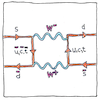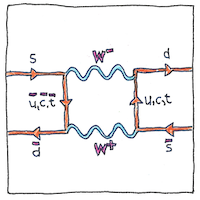James Cronin,
Val Fitch
physics

|
CP violation
Physicists thought elementary particles should be symmetrical. A particle and its antiparticle should have a opposite charges, and they should have opposite parity, so that their physical arrangements would be mirror images of each other. That is, it was thought that matter and antimatter should follow the same rules. Particles violate parity, known as the parity violation; therefore, physicists hoped they wouldn’t violate the product of charge conjugation symmetry and parity symmetry. If we considered more than one symmetry, maybe we could get back to where we were. However, James Cronin and Val Fitch studied the decays of neutral kaons and showed that the probability of a kaon transforming into its antikaon is different from the probability of an antikaon transforming into a kaon, so weak interactions violate P, C, and CP-symmetries.
Mirror images
If the future were a mirror of the past, hey, we’re in trouble, mister. The farther we get from the past, the rosier it seems. The future reflects what we see around us, but we can’t step into it.
T violation
If you think about time in spacial terms, you could think it travels in only one direction, but time is different from space. It’s not like width, breadth, or height except on a chart. There’s no way to travel to the future except the slow way, one millisecond at a time. When shit happens, it’s not beside, above, or below; it’s all over, then it’s over.



At this time, it seems, still, no one knows why these things are not symmetrical. It’s just that, conveniently, if they were symmetrical, then there would be as much antimatter as matter in this universe, which could mean that we would be creatures of pure energy.
See also in The book of science:
Readings in wikipedia: